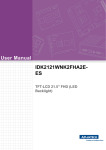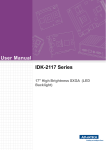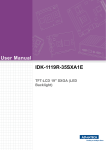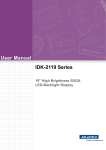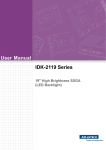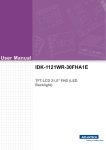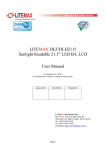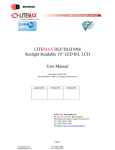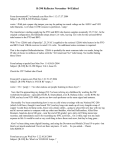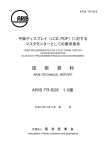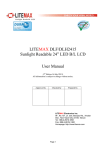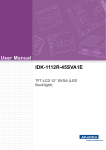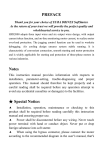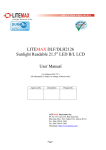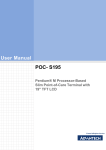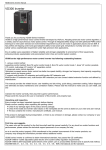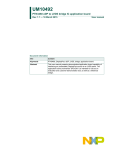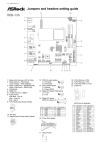Download Advantech IDK-2121W User Manual
Transcript
User Manual IDK-2121W Series TFT-LCD 21.5” FHD (LED Backlight) Copyright The documentation and the software included with this product are copyrighted 2013 by Advantech Co., Ltd. All rights are reserved. Advantech Co., Ltd. reserves the right to make improvements in the products described in this manual at any time without notice. No part of this manual may be reproduced, copied, translated or transmitted in any form or by any means without the prior written permission of Advantech Co., Ltd. Information provided in this manual is intended to be accurate and reliable. However, Advantech Co., Ltd. assumes no responsibility for its use, nor for any infringements of the rights of third parties, which may result from its use. Acknowledgements AMI is a trademark of American Megatrends Inc. IBM and PC are trademarks of International Business Machines Corporation. Intel® Core 2 Quad, Pentium Dual Core and Celeron are trademarks of Intel Corporation. WinBond is a trademark of Winbond Corporation. All other product names or trademarks are properties of their respective owners. IDK-2121W User Manual Part No. 2006212101 Edition 2 Printed in China July 2013 ii A Message to the Customer Advantech Customer Services Each and every Advantech product is built to the most exacting specifications to ensure reliable performance in the harsh and demanding conditions typical of industrial environments. Whether your new Advantech equipment is destined for the laboratory or the factory floor, you can be assured that your product will provide the reliability and ease of operation for which the name Advantech has come to be known. Your satisfaction is our primary concern. Here is a guide to Advantech’s customer services. To ensure you get the full benefit of our services, please follow the instructions below carefully. Technical Support We want you to get the maximum performance from your products. So if you run into technical difficulties, we are here to help. For the most frequently asked questions, you can easily find answers in your product documentation. These answers are normally a lot more detailed than the ones we can give over the phone. So please consult this manual first. If you still cannot find the answer, gather all the information or questions that apply to your problem, and with the product close at hand, call your dealer. Our dealers are well trained and ready to give you the support you need to get the most from your Advantech products. In fact, most problems reported are minor and are able to be easily solved over the phone. In addition, free technical support is available from Advantech engineers every business day. We are always ready to give advice on application requirements or specific information on the installation and operation of any of our products. iii IDK-2121W User Manual Product Warranty (2 years) Advantech warrants to you, the original purchaser, that each of its products will be free from defects in materials and workmanship for two years from the date of purchase. This warranty does not apply to any products which have been repaired or altered by persons other than repair personnel authorized by Advantech, or which have been subject to misuse, abuse, accident or improper installation. Advantech assumes no liability under the terms of this warranty as a consequence of such events. Because of Advantech’s high quality-control standards and rigorous testing, most of our customers never need to use our repair service. If an Advantech product is defective, it will be repaired or replaced at no charge during the warranty period. For outof-warranty repairs, you will be billed according to the cost of replacement materials, service time and freight. Please consult your dealer for more details. If you think you have a defective product, follow these steps: 1. Collect all the information about the problem encountered. (For example, CPU speed, Advantech products used, other hardware and software used, etc.) Note anything abnormal and list any onscreen messages you get when the problem occurs. 2. Call your dealer and describe the problem. Please have your manual, product, and any helpful information readily available. 3. If your product is diagnosed as defective, obtain an RMA (return merchandise authorization) number from your dealer. This allows us to process your return more quickly. 4. Carefully pack the defective product, a fully-completed Repair and Replacement Order Card and a photocopy proof of purchase date (such as your sales receipt) in a shippable container. A product returned without proof of the purchase date is not eligible for warranty service. 5. Write the RMA number visibly on the outside of the package and ship it prepaid to your dealer. IDK-2121W User Manual iv Contents Chapter 1 Overview...............................................1 1.1 1.2 General Description .................................................................................. 2 Display Characteristics.............................................................................. 2 Table 1.1: Display Characteristics ............................................... 2 Optical Characteristics .............................................................................. 3 Table 1.2: Display Characteristics ............................................... 3 Functional Block Diagram ......................................................................... 6 Figure 1.1 Function block diagram .............................................. 6 Absolute Maximum Ratings ...................................................................... 7 1.5.1 Absolute Ratings of TFT LCD Module .......................................... 7 1.5.2 Absolute Ratings of Environment.................................................. 7 Outline Dimension..................................................................................... 8 1.6.1 IDK-2121WR-K2FHA2E................................................................ 8 1.6.2 IDK-2121WN-K2FHA2E................................................................ 9 1.3 1.4 1.5 1.6 Chapter 2 Electrical Characteristics .................11 2.1 TFT LCD Power Consumption ................................................................ 12 Table 2.1: Power specification................................................... 12 2.1.1 Signal Electrical Characteristics.................................................. 13 Table 2.2: Signal electrical characteristics ................................ 13 Backlight Driving Conditions ................................................................... 13 Table 2.3: Backlight driving conditions ...................................... 13 2.2 Chapter 3 Signal Characteristics .......................15 3.1 3.2 3.5 Pixel Format Image ................................................................................. 16 Pin Description ........................................................................................ 16 Table 3.1: Pin Description ......................................................... 16 The Input Data Format ............................................................................ 18 Interface Timing ...................................................................................... 19 3.4.1 Timing Characteristics ................................................................ 19 3.4.2 Input Timing Diagram.................................................................. 19 Power ON/OFF Sequence ...................................................................... 20 4 Connector & Pin Assignment ...........21 4.1 TFT LCD Module..................................................................................... 22 4.1.1 Connector ................................................................................... 22 Table 4.1: Connector ................................................................. 22 4.1.2 Pin Assignment ........................................................................... 22 Table 4.2: Pin Assignment......................................................... 22 Backlight Unit .......................................................................................... 22 4.2.1 Input Connector for LED Driver Board ........................................ 22 4.2.2 LED Driver Board........................................................................ 23 Table 4.3: Specification ............................................................. 23 Figure 4.1 Dimension................................................................. 24 3.3 3.4 Chapter 4.2 Appendix A Handling Precautions........................25 A.1 Optical Characteristics ............................................................................ 26 v IDK-2121W User Manual IDK-2121W User Manual vi Chapter 1 Overview 1 1.1 General Description IDK-2121W series is a Color Active Matrix Liquid Crystal Display composed of a TFTLCD panel, a driver circuit, and backlight system. The screen format is intended to support the FHD (1920(H) x 1080(V)) screen and 16.7M colors (RGB 8-bits data). All input signals are dual LVDS interface. Driver board for the backlight is included. 1.2 Display Characteristics The following are characteristics summary under 25°C condition: Table 1.1: Display Characteristics Item Unit Description Screen Diagonal [mm] 546.86(21.53”) Active Area [mm] 476.64 (H) x 268.11 (V) Pixels H x V 1920 (x3) x 1080 Pixel Pitch 248.25 (per one triad) × 248.25 Pixel Arrangement [um] Display Mode White Luminance (Center) R.G.B. Vertical Stripe VA Mode, Normally Black [cd/m2] 1200 (Typ.) Optical Response Time [msec] 16 ms (Typ., on/off) Input Voltage VDD [Volt] +5.0 V Backlight Input Voltage [Volt] +12.0 V Power Consumption (VDD line + LED line) [Watt] VDD: 4.4 + PLED: 43.56 = 48 (Typ.) (with LED driver board, all white pattern) Weight [Grams] R series: 3200 (Typ.) N series: 2400 (Typ.) Physical Size [mm] R series: 495.6(W) × 292.2(H) × 21.65(D) Typ. N series: 495.6(W) × 292.2(H) × 17.7(D) Typ. Contrast Ratio 3500:1 (Typ.) Electrical Interface Dual channel LVDS Support Color 16.7M colors (RGB 8 bits) Surface Treatment Anti-Glare, 3H Temperature Range Operating Storage (Shipping) RoHS Compliance IDK-2121W User Manual [°C] [°C] N-series/R series 0 to 55 -20 to 60 RoHS Compliance 2 Table 1.2: Display Characteristics Item Viewing Angle Unit [degree] Response Time [msec] Min. Typ. Max. Horizontal CR = 1 150 178 - Vertical CR = 10 150 178 - Normal Direction - 3500 - Raising Time (TrR) - 10 12 Falling Time (TrF) - 6 7 Raising + Falling - 16 19 6500K 8500K 11000K 5 Color temperature Note 1, 2 3 4 Central Luminance [cd/m2] 1100 1200 - 6 Luminance Uniformity [%] 75 85 - 7 Crosstalk (in 60Hz) [%] 1.5 8 Flicker dB -20 9 Note 1: Measurement Method Before measuring, the LCD module should be turn on 30 minutes at room temperature. In order to stabilize the luminance, the measurement should be executed after lighting Backlight for 30 minutes in a stable, windless and dark room. 3 IDK-2121W User Manual Overview Contrast ratio Conditions Chapter 1 1.3 Optical Characteristics Note 2: Definition of viewing angle measured by ELDIM (EZContrast 88) Viewing angle is the measurement of contrast ratio at the screen center, over a 180°horizontal and 180°vertical range (off-normal viewing angles). The 180° viewing angle range is broken down as below: 90° (θ)? horizontal left and right, and 90° (Φ) vertical high (up) and low (down). The measurement direction is typically perpendicular to the display surface with the screen rotated to its center to develop the desired measurement viewing angle. Note 3: Contrast ratio is measured by TOPCON SR-3 Note 4: Definition of Response time measured by Westar TRD-100A The output signals of photo detector are measured when the input signals are changed from “Full Black” to “Full White” (rising time, TrR), and from “Full White” to “Full Black” (falling time, TrF), respectively. The response time is interval between the 10% and 90% (1 frame at 60Hz) of amplitudes. TrR + TrF = 16msec (typ.) Note 5: Color chromaticity and coordinates (CIE) is measured by TOPCON SR-3 Note 6: Central luminance is measured by TOPCON SR-3 IDK-2121W User Manual 4 90 % 50 % 10 % 10 % Chapter 1 Note 7: Luminance uniformity of these 9 points is defined as below and measured by TOPCON SR-3 50 % Note 8: Crosstalk is defined as below and measured by TOPCON SR-3 CT = | YB- YA| / YA * 100(%) Where YA = Luminance of measured location without gray level 0 pattern (cd/m2) YB = Luminance of measured location with gray level 0 pattern (cd/m2) Note 9: Test Patern: subchecker pattern measured by TOPCON SR-3 Method: Record dB value with TRD-100 5 IDK-2121W User Manual Overview 90 % 1.4 Functional Block Diagram The following diagram shows the functional block of the 21.5 inches Color TFT-LCD Module: Figure 1.1 Function block diagram IDK-2121W User Manual 6 Absolute maximum ratings of the module is as following: 1.5.1 Absolute Ratings of TFT LCD Module Symbol Min. Max. Unit Conditions Logic/LCD Drive Voltage VDD 0 5.5 [Volt] Note 1,2 Conditions 1.5.2 Absolute Ratings of Environment Item Symbol Min. Max. Unit Operating Temperature TOP 0 55 [°C] Operation Humidity HOP 10 +90 [%RH] Storage Temperature TST -20 60 [°C] Storage Humidity HST 5 90 [%RH] Note 3 Note 1: Within Ta (25°C) Note 2: Permanent damage to the device may occur if exceeding maximum values Note 3: For quality performance, please refer to AUO IIS (Incoming Inspection Standard). 7 IDK-2121W User Manual Overview Item Chapter 1 1.5 Absolute Maximum Ratings 1.6 Outline Dimension 1.6.1 IDK-2121WR-K2FHA2E Front View Rear View IDK-2121W User Manual 8 Chapter 1 1.6.2 IDK-2121WN-K2FHA2E Front View Overview Rear View 9 IDK-2121W User Manual IDK-2121W User Manual 10 Chapter 2 Electrical Characteristics 2 2.1 TFT LCD Power Consumption Input power specifications are as follows: Table 2.1: Power specification Symbol Parameter Min. Typ. Max. Unit Condition VDD Logic/LCD Drive Voltage 4.5 5.0 5.5 [Volt] 10% - 0.7 0.8 [A] VDD= 5.0V,All white pattern, At 60Hz 0.81 0.89 [A] VDD= 5.0V, All white pattern At 75Hz 3.5 4.4 [Watt] VDD= 5.0V,All white pattern, At 60Hz 4.05 4.9 [Watt] VDD= 5.0V, All white pattern At 75Hz IDD Input Current - PDD VDD Power IRush Inrush Current - - 3 [A] Note 1 VDDrp Allowable Logic/ LCD Drive Ripple Voltage - - 500 [mV] p-p VDD= 5.0V, All white Pattern At 75Hz Note1 Measurement condition: The duration of raising time of power input is 47us. IDK-2121W User Manual 12 Input signals shall be low or Hi-Z state when VDD is off. Table 2.2: Signal electrical characteristics Parameter Min. Typ. Max. Unit Condition VTH Differential Input High Threshold - - +100 [mV] VCM = 1.2V, Note 1 VTL Differential Input Low Threshold -100 - - [mV] VCM = 1.2V Note 1 | VID | Input Differential Voltage 100 - 600 [mV] Note 1 VCM Differential Input Common Mode Voltage +1.0 +1.2 +1.5 [V] VTH-VTL = 200MV (max) Note 1 Note LVDS Signal Waveform. 2.2 Backlight Driving Conditions Parameter guideline for LED Light Bar Driver is under stable conditions at 25°C (Room Temperature): Table 2.3: Backlight driving conditions Item Symbol Values Unit Condition Min. Typ. Max. LED Voltage VL - - 19 V Note 2 LED Current IL - - 1000*2 mA Note 2 LED life time - 50,000 - - Hr Note 1 Note1 The "LED life time" is defined as the module brightness decreased to 50% original brightness and the ambient temperature is 25°C and typical LED Current at 950 mA. Note2 The LED driving condition is defined for each LED module.(10 LED Serial). Note3 The variance of LED Light Bar power consumption is 10%. Calculator value for reference (IL x VL x 2 = PLED) 13 IDK-2121W User Manual Electrical Characteristics Symbol Chapter 2 2.1.1 Signal Electrical Characteristics IDK-2121W User Manual 14 Chapter 3 3 Signal Characteristics 3.1 Pixel Format Image Following figure shows the relationship between input signal and LCD pixel format. 3.2 Pin Description The module using a pair of LVDS receiver SN75LVDS82 (Texas Instruments) or compatible. LVDS is a differential signal technology for LCD interface and high speed data transfer device. Transmitter shall be SN75LVDS83 (negative edge sampling) or compatible. The first LVDS port (RxOxxx) transmits odd pixels while the second LVDS port (RxExxx) transmits even pixels. Table 3.1: Pin Description Pin No. Symbol Description 1 RxO0- Negative LVDS differential data input (Odd data) 2 RxO0+ Positive LVDS differential data input (Odd data) 3 RxO1- Negative LVDS differential data input (Odd data) 4 RxO1+ Positive LVDS differential data input (Odd data) 5 RxO2- Negative LVDS differential data input (Odd data, H-Sync,VSync,DSPTMG) 6 RxO2+ Positive LVDS differential data input (Odd data, H-Sync,VSync,DSPTMG) 7 VSS Power Ground 8 RxOC- Negative LVDS differential clock input (Odd clock) 9 RxOC+ Positive LVDS differential clock input (Odd clock) 10 RxO3- Negative LVDS differential data input (Odd data) 11 RxO3+ Positive LVDS differential data input (Odd data) 12 RxE0- Negative LVDS differential data input (Even data) 13 RxE0+ Positive LVDS differential data input (Even data) 14 VSS Power Ground IDK-2121W User Manual 16 RxE1- Negative LVDS differential data input (Even data) 16 RxE1+ Positive LVDS differential data input (Even data) 17 VSS Power Ground 18 RxE2- Negative LVDS differential data input (Even data) 19 RxE2+ Positive LVDS differential data input (Even data) 20 RxEC- Negative LVDS differential clock input (Even clock) 21 RxEC+ Positive LVDS differential clock input (Even clock) 22 RxE3- Negative LVDS differential data input (Even data) 23 RxE3+ Positive LVDS differential data input (Even data) 24 VSS Power Ground 25 NC No connection (for AUO test only. Do not connect) 26 NC No connection (for AUO test only. Do not connect) 27 NC No connection (for AUO test only. Do not connect) 28 VDD Power +5V 29 VDD Power +5V 30 VDD Power +5V Note1: Input signals of odd and even clock shall be the same timing. Note2: Please follow VESA. 17 IDK-2121W User Manual Signal Characteristics 15 Chapter 3 Table 3.1: Pin Description 3.3 The Input Data Format Note1: Normally DE mode only. VS and HS on EVEN channel are not used. Note2: Please follow VESA. Note3: 8-bit in IDK-2121W User Manual 18 3.4.1 Timing Characteristics Item Symbol Min. Typ. Max. Unit Clock Frequency 1/ TClock 40 72 83 MHz Frame Rate Frequency 1/Tv 50 60 75 Hz Period TV 1088 1120 2047 Active TVD 1080 1080 1080 Blanking TVB 8 40 967 Vertical Section Horizontal Section Period TH 1034 1060 2047 Active THD 960 960 960 Blanking THB 74 100 1087 T_line T_clock Note: DE mode. 3.4.2 Input Timing Diagram 19 IDK-2121W User Manual Signal Characteristics Signal Name Chapter 3 3.4 Interface Timing 3.5 Power ON/OFF Sequence VDD power and lamp on/off sequence is as follows. Interface signals are also shown in the chart. Signals from any system shall be Hi-Z state or low level when VDD is off. Power Sequence Timing Parameter T1 Value Min. Typ. Max. 0.5 - 10 Unit [ms] T2 30 40 50 [ms] T3 200 - - [ms] T4 0.5 - 10 [ms] T5 10 - - [ms] T6 10 - - [ms] T7 0 - - [ms] T8 10 - - [ms] T9 - - 10 [ms] T10 110 - - [ms] T11 0 16 50 [ms] T12 - - 10 [ms] T13 1000 - - [ms] IDK-2121W User Manual 20 Chapter 4 Connector & Pin Assignment 4 4.1 TFT LCD Module The physical connector interface is described below. These connectors are capable of accommodating the following signals and components. 4.1.1 Connector Table 4.1: Connector Connector Name / Description Interface Connector / Interface card Manufacture JAE or compatible Type Part Number JAE (FI-XB30SRL-HF11) or equivalent Mating Housing Part Number FI-X30HL (JAE) or compatible 4.1.2 Pin Assignment Table 4.2: Pin Assignment Pin No. Signal Name Pin No. Signal Name 1 RxOIN0- 2 RxOIN0+ 3 RxOIN1- 4 RxOIN1+ 5 RxOIN2- 6 RxOIN2+ 7 GND 8 RxOCLKIN- 9 RxOCLKIN+ 10 RxOIN3- 11 RxOIN3+ 12 RxEIN0- 13 RxEIN0+ 14 GND 15 RxEIN1- 16 RxEIN1+ 17 GND 18 RxEIN2- 19 RxEIN2+ 20 RxECLKIN- 21 RxECLKIN+ 22 RxEIN3- 23 RxEIN3+ 24 GND 25 NC 26 NC 27 NC 28 VDD 29 VDD 30 VDD 4.2 Backlight Unit The physical connector interface is described below. These connectors are capable of accommodating the following signals and components. 4.2.1 Input Connector for LED Driver Board Connector Name / Designation Interface Connector / Interface card Manufacturer JST or compatible Type Part Number PHR-6 or compatible IDK-2121W User Manual 22 Pin Definition 1 Vin(+12V) 2 Vin(+12V) 3 GND 4 GND 5 ON/OFF(0V: Off ; +5V: On) 6 Dimming (PWM) 4.2.1.2 LED driver board output connector pin define (CN1,CN2): Pin No. Pin Definition 1 VLED- 2 VLED+ 4.2.2 LED Driver Board 4.2.2.1 Specification: Table 4.3: Specification Symbol Characteristics Condition Voltage Efficiency Vin=12V, Iout=950mA, Vout=19V Power 1 port output Input Min. Typ. Max. Unit 10.8 12 13.2 V 90 3 Voltage Output Current 1 port output Current Accuracy 150mAIout950m A 100 5 ON/OFF Voltage W V 1000 mA 10 % OVP Thermal Shutdown Dimmer (Note 1) 30 19.8 Protection Environment % 165 Operation Junction Temperature °C 125 °C Operating Temperature -20 +70 °C Storage Temperature -40 + 85 °C Dimmer range 5 100 % Dimmer VH 3 5 V Dimmer VL 0 1.5 V Dimmer Frequency 0.5 40 KHz Von 3 5.5 V Voff 0 2 V 23 IDK-2121W User Manual Connector & Pin Assignment Pin No. Chapter 4 4.2.1.1 LED driver board input connector pin define (CN4): 4.2.2.2 LED driver board dimension Figure 4.1 Dimension IDK-2121W User Manual 24 Appendix A A Handling Precautions A.1 Optical Characteristics The optical characteristics are measured under stable conditions at 25°C (Room Temperature) 1. Since the front polarizer is easily damaged, pay attention not to scratch it. 2. Be sure to turn off the power supply when inserting or disconnecting from the input connector. 3. Wipe off water drops immediately. Long contact with water may cause discoloration or spots. 4. When the panel surface is soiled, wipe it with absorbent cotton or other soft cloth. 5. Since the panel is made of glass, it may break or crack if dropped or bumped on hard surface. 6. Since CMOS LSI is used in this module, take care of static electricity and insure you are earthed when handling. 7. Do not open or modify the Module Assembly. 8. Do not press the reflector sheet at the back of the module from any direction. 9. In case if a Module has to be put back into the packing container slot after it was taken out, please press the far end of the LED light bar reflector edge softly, otherwise the TFT Module may be damaged. 10. At the insertion or removal of the Signal Interface Connector, be sure not to rotate nor tilt the Interface Connector of the TFT Module. 11. After installation of the TFT Module into an enclosure, no bending/twisting forces should be applied to the TFT Module. Otherwise the TFT Module may be damaged. 12. Small amounts of materials having a no flammability grade are used in the LCD module. The LCD module should be supplied by power complying with the requirements of Limited Power Source (IEC60950 or UL1950) IDK-2121W User Manual 26 www.advantech.com Please verify specifications before quoting. This guide is intended for reference purposes only. All product specifications are subject to change without notice. No part of this publication may be reproduced in any form or by any means, electronic, photocopying, recording or otherwise, without prior written permission of the publisher. All brand and product names are trademarks or registered trademarks of their respective companies. © Advantech Co., Ltd. 2013

































